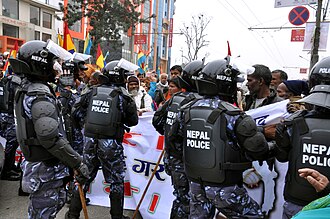In these dark and reactionary times, it is worth noting that despite the barrage of propaganda from the media controlled by the State and the capitalists, that struggle is not dead. We have seen the recent transport strikes in London, the uprising in Indonesia and the blockades on September 10th in France. The ACG hopes to comment on all of these events, but here we look at another important happening, the uprising in Nepal.
A huge wave of popular anger engulfed the Nepalese government, when on September 4th it sought to close 26 social media platforms. The excuse for this was the suppression of hate speech, but the real reason was the closing down of dissent. Economic conditions have forced two million workers to relocate all around the world, and for them social media is the main way they keep in contact with their families. About 90% of the population use social media.
There has long been widespread anger about the corruption of politicians, and this was quickly expressed on placards held by thousands of protestors who turned out on the streets of the capital Kathmandu on that day. Many of these were young, and some were wearing school uniforms. The police responded with violence, with the use of baton charges and water cannon. This only increased the anger of the demonstrators. On September 8th, the police escalated this violence, firing on the crowd and killing protestors. So far the figure of those slain by State forces has risen to 25 but may well increase. Many were shot in the head or chest in deliberate targeted killings. Curfews were imposed by the government, but this failed to deter.
In response the offices of political parties were set on fire, as well as the houses of political leaders. Some of these politicians had to be rescued from angry protestors by climbing up ropes dangled by police helicopters, in a desperate attempt to escape popular anger. This was followed by the burning of the Congress (Parliament) building. The Prime Minister Khadga Prasad Sharma Oli was forced to resign. Shortly after, his house was burnt down. The Home Office Minister Ramesh Lekhak had resigned the previous day, after claiming moral responsibility for the repression. The ban on social media was lifted, but now the army is taking control of the streets.
How did this all come about? One reason for the ban was the release of material on social media, showing the extravagant lifestyle of the Nepalese elite. This is in a country with very high levels of poverty and 20 % youth unemployment. But discontent has been simmering for a long time, and the release of this material and then the ban, were just sparks that ignited a social flare up.
The revolt wasn’t led by any particular group, so it appears. It was a decentralised occurrence, spearheaded by young people with no allegiance to any of the parties, plagued by unemployment and the forced need to emigrate to find employment. Just last year, 740,000 people were forced to emigrate.
Nepal evolved from a Hindu monarchy into a secular bourgeois democracy, following a civil war with Maoist guerillas which led to a parliamentary monarchy and ultimately the monarchy’s abolition. Since then, various parties have ruled, including some calling themselves Communist, including from among the former Maoist guerillas. All of these quickly adapted to the system and to the corrupt practices of the elite. This elite enriched itself tremendously, and these rich families operate a system of nepotism, where their sons and daughters inherit parliamentary seats, government and party positions, State contracts and ambassadorial positions.
A group called the Safal or Nepal Workers’ Street Committee has emerged, and has issued a statement , saying that the events were a “first shot in the class war” and calling for the police to be disarmed and the masses to be armed, and the dissolution of parliament. It remains to be seen whether this is a genuine group, organically related to the revolt, or an attempt by Communist elements to rehabilitate themselves.
Whatever, the revolt indicates the simmering dissent not just in Nepal, but around the world. The ruling elites in both India and China should take note and tremble. Revolution is still possible, whether in the East or the West.

